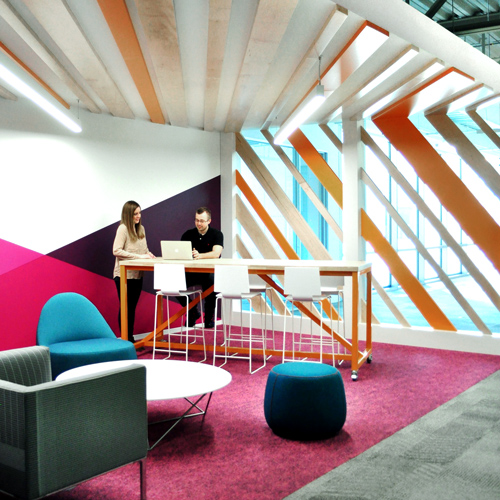A little more than 40 years ago, founder Olivier Baussan embarked on a dream to change the world by creating cosmetic products that didn’t emphasize chemicals, but rather the scenic flora of his native Provence. His effort wasn’t only conceived to utilize the power of nature, but to pay homage to his beloved homeland in the southeast of France.
Not all customers of L’Occitane may be able to visit the Provence region, but fortunately, they can still experience the French terrain through the company’s products and store spaces. With more than 250 stores in North America alone, Paul Blackburn, associate vice president of design and construction, is making this vision a reality.
Blackburn’s two most recent projects have kicked off a new, technologically minded experiential strategy for store design. The strategy began in early 2016 with a pristine, 2,500-square-foot location in Disney World, and has continued through a remodeling of L’Occitane’s highly trafficked flagship store in the heart of Manhattan’s Flatiron District.
While some say that retail locations are a design of the past, Blackburn believes they will never truly go extinct.
“Physical retail space gives companies a way to engage with customers that online shopping can’t and will never be able to do . . . until Web 3.0,” he says. Blackburn’s new projects maintain this focus by making the L’Occitane experience truly bow to the physical consumer.
This is not to say that the company excludes its online experience—North America accounts for the most mature online market that L’Occitane has anywhere in the world. In a survey conducted by UPS in 2016, L’Occitane shoppers made 51 percent of their purchases online. These numbers are part of a larger trend of some shoppers’ allegiance to comfort and convenience, where a click in the comfort of a home or office is more appealing than physically shopping.
So when faced with the popularity of online sales, Blackburn had to ask, what is missing from the in-store experience? But perhaps the better question is, how can retailers and designers create a better one? L’Occitane, as well as many other store brands, is trying to bottle a unique experience that is supported by an omnichannel operation. Customers are simply hungry for more than what they’ve been given. Blackburn believes this is a call to action for multi-sensory activation. The beauty industry and L’Occitane already have a leg up, as a huge part of the industry relies on the consumers connecting with particular physicalities—the touch of almond oil, or the smell of verbena, for example. L’Occitane goes even further with humanitarian versions of sensory appreciation, as it is one of the first companies to put braille on packing, which it did in 1997.
Blackburn used the Disney project to conceptualize a new kind of storytelling. “We used the theater and the excitement of Disney to influence how we could tell our L’Occitane story in a Disney way,” Blackburn says. The result of this influence was the recreation of an original L’Occitane soap factory, which Blackburn and his team felt was the most authentic way to tell the story of its products. The Disney project is the most technologically heavy store they have created in North America, as it employed a laser engraving machine and skin care diagnostic tools. Most importantly, Blackburn says, they have been able to learn from the experience and apply those lessons to further the
Flatiron project.
Part of the strategy in creating a one-of-a-kind experience is slowing down the consumer’s need for instant gratification. The Flatiron store should be seen as a slow space that has nothing to do with gratification, urban culture, or the clock. The layout of the Flatiron is broken down into segments based on the amount of time consumers have to shop. “In the fast-paced world that we live in, one of the most valuable commodities that you can give anybody is time. And we really wanted to respect that,” Blackburn says.
That respect comes through the carefully considered segments: the front of the store is styled as the Provençal town square and is designed primarily for a customer who only has a few minutes. The town square contains the pillars of the L’Occitane brand, which include its best-selling skincare, fragrances, and gifts. For customers who have more time to browse, the connection zone utilizes a design that’s a bit more thought-provoking. This zone contains the brand’s full range of products—displayed on white bookcase-style shelves, gently lit with the intimacy of bowl lighting.
The back of the store, known as the hospitality space, contains the heart of the technology. It is graced with a canopy of flowers that changes seasonally (for example, it showcased two miles of ribbon for the holidays), a concierge on call, and a hand cream bar. Not only do these services pay homage to how time plays a role in this space, but it also does so through a sense of community.
“For this particular project, it was really that sense of community that we wanted to translate into the store design and the experience, compared to some locations where we might use an influence that’s a little bit more physical,” Blackburn says.
The Flatiron store presents itself as two cities: the one of physicality and one of technology. The design doesn’t disconnect the shopper with technology, but instead offers it as complementary. Blackburn calls it “technology without losing the human connection.” His strategy is an attempt to combine both bustling metropoles. It was imperative to Blackburn and his team that any digital element proposed would add value and not just be a gimmick.
This is where the smart beauty fitting room comes in. Originally bringing the idea from the communal texture bar from the Disney project, this ambitious structure is what drives the digital blood throughout this space. It stands as a communal table with four separate stations, each having a sink and digital touch screen terminal set into the table. The customers can use the screens to browse products by concern or name, and requests are then added to a tester basket.
Before it was able to conceptualize what the in-store technology would look like, L’Occitane sought and found solace in a partnership with School House. Nearly all of L’Occitane’s 3,000 stores were designed internally, but to embark on this journey, it needed some help. The company worked hand in hand for the better part of six months, ending with an aggressive six-week construction schedule.
But it was not one that was clean of construction calamity. For the grand opening of the original Flatiron store in 2011, scaffolding plagued the entire building only to come down the night before the store opened. And during this new remodeling, two weeks before construction, scaffolding was erected. Among the anxiety and flashback to the previous build, the morning of November 23 during the soft-open of the Flatiron project, the scaffolding came down.
He may be at the helm of creating new precedents for in-store experiences, but Blackburn doesn’t let this go to this head,
“I try to keep in the back of my mind,” he says, “‘Will I still be pleased with this in five years, ten years’ time?’”


